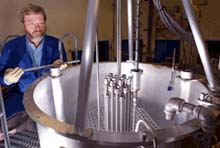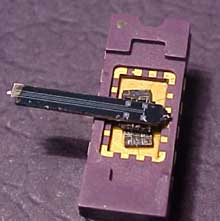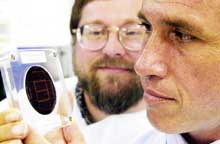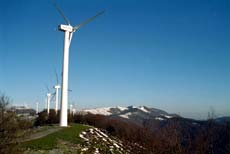
A first in Canada, the Alberta Research Council (ARC) reached a milestone in the technical development of its own version of solid oxide fuel cell (SOFC) technology. ARC scientists are developing a proprietary micro solid oxide fuel cell (µ-SOFC) source of energy for small-scale portable applications such as laptops or personal digital assistants (PDAs).
“This is an important milestone as we pursue our strategic initiative in fuel cell technologies,” says John Zhou, manager, Advanced Materi

The “island effect” is one of the main problems in photovoltaic compound solar systems.
The doctoral thesis of Pablo Sanchis, presented in the Public University of Navarre (Basque Country), proposes three main contributions: the first one is a new control strategy of a booster inverter for autonomous systems; the second one is a new implementation of impedance measurement method, and the third one, a new methodology for the design of drift method in frequency, which guarantees with t

Recent experiments by Sandia National Laboratories researcher Gary Harms and his team are using a new Labs-built reactor to provide benchmarks showing that spent nuclear fuel — uranium that has been used as fuel at a nuclear power plant — is considerably less reactive than the original fresh fuel. This could mean significant savings in the eventual safe transport, storage, and disposal of nuclear waste.
“The conservative view has always been to treat spent fuel like it just came out of the

Oak Ridge National Laboratory and 3M Company are hoping for powerful results from a project aimed at making transmitting electricity more efficient and reliable.
Researchers from 3M, working with ORNL, are developing a promising replacement conductor for conventional power lines that addresses the problem of power outages caused by sagging lines. Lines sag under the heat of high current loads. The replacement conductor also avoids the high cost and environmentally harmful effects of buildin

A large study comparing trucks fueled by natural gas with others fueled by diesel found the natural gas vehicles produced only a quarter of the carbon monoxide emissions and half the oxides of nitrogen emissions of their diesel counterparts.
The study was conducted using package trucks operated by United Parcel Service (UPS), which has the nation’s largest private compressed natural gas (CNG) fleet. The study compared the operations, maintenance, performance, and emissions characteristics

A wheelchair robot developed by scientists at Coimbra University already has a prototype “capable of navigating without colliding with obstacles by commanded human voice”, as professor Urbano Nunes states, the person with joint responsibility, with professor Gabriel Pires, for the team of professors and students of the Electro-technical Engineering Department responsible for the project.
For the last five years this project has been developed and integrated in degree classes and pos

One of the world’s largest and most successful experimental fusion machines has been safely disassembled and cleared away. In September, staff at the U.S. Department of Energy’s (DOE) Princeton Plasma Physics Laboratory (PPPL) completed the dismantling and removal of the Tokamak Fusion Test Reactor (TFTR), which shut down in 1997 following 15 years of operation. During its experimental life, TFTR set records for fusion performance and made major contributions to the development of fusion as

While electronic circuits and nanomachines grow ever smaller, batteries to power them remain huge by comparison, as well as short-lived. But now Cornell University researchers have built a microscopic device that could supply power for decades to remote sensors or implantable medical devices by drawing energy from a radioactive isotope.
The device converts the energy stored in the radioactive material directly into motion. It could directly move the parts of a tiny machine or could generat

High Level Group for Hydrogen and Fuel Cell
Thank you Madam Vice President, and thank you again, (Ladies and) gentlemen for your attention.
Madam de Palacio has presented to you our concerns in the European Union over Global climate change, energy security and transport. We are committed to achieving sustainable development.
We re-stated our commitment in Johannesburg and are embarking on a comprehensive range of measures. This includes research on the most promisi

It would send and receive faxes and video and have the processing power of a personal computer. The cell phone of the future would be on the market today but for one hitch: the battery.
The technology is available to build cell phones that would make the latest versions — those that allow users to send pictures and play video games — seem almost primitive. But the batteries now used in cell phones are not nearly powerful enough to drive all the fancy add-ons, said Charles Martin, a Univers

UH Solar Cell Research Has Applications for Space Exploration, Clean Cars
New technologies designed to harness the power of the sun may hold the key to successful moon colonies, cheaper and lighter-weight satellites, and cleaner-burning, more efficient car engines.
Solar cells, electronic devices that convert sunlight into useful electricity, would be an important resource for powering future industrial bases or colonies on the moon. Alex Freundlich, research professor of ph

The European Commission has accepted EVE, the Basque Energy Entity, and Eolicas de Euskadi within the programme to promote renewable energy. The European Union is aware of the effort EVE is doing to obtain 12 % of primary energy from renewable energy. This entity has been accepted in the programme Campaign for Take-Off, together with Eolicas de Euskadi. The programme has been designed by the European Commission and as the first step they want to create a Renewable Energy Partnership. This partnership

MIT team is part of project
A 150-ton magnet developed in part by MIT engineers is pulling the world closer to nuclear fusion as a potential source of energy.
Over the last three years “we’ve shown that we can design a magnet of this size and complexity and make it work,” said Joseph V. Minervini, a senior research engineer at MIT’s Plasma Science and Fusion Center (PSFC) and Department of Nuclear Engineering. Minervini leads the MIT team involved in the project.

Penn State engineers have optimized an energy harvesting circuit so that it transfers four times more electrical power out of vibration – the ordinary shakes and rattles generated by human motion or machine operation.
Using their laboratory prototype, which was developed from off-the-shelf parts, the Penn State researchers can generate 50 milliwatts. Although they haven’t tried it, they believe the motion of a runner could be harnessed to generate enough power to run a portable electron

The basque technology centre CIDETEC is working on a project about lithium-polymer energy with the collaboration of the companies CEGASA and ZIGOR.
Actually, they are in the first stage of the project. Initially, they analysed the structure, design and development of different electrode materials with multiple characteristics (cathode and anode) to use lithium-polymer in batteries.
The results of the project enabled the development of a lab-scale prototype of a rechargeable

In the search for a nonpolluting energy source, hydrogen is often cited as a potential source of unlimited clean power. But hydrogen is only as clean as the process used to make it. Currently, most hydrogen is made from fossil fuels like natural gas using multi-step and high-temperature processes.
Now, chemical engineers at the University of Wisconsin-Madison have developed a new process that produces hydrogen fuel from plants. This source of hydrogen is non-toxic, non-flammable and can be